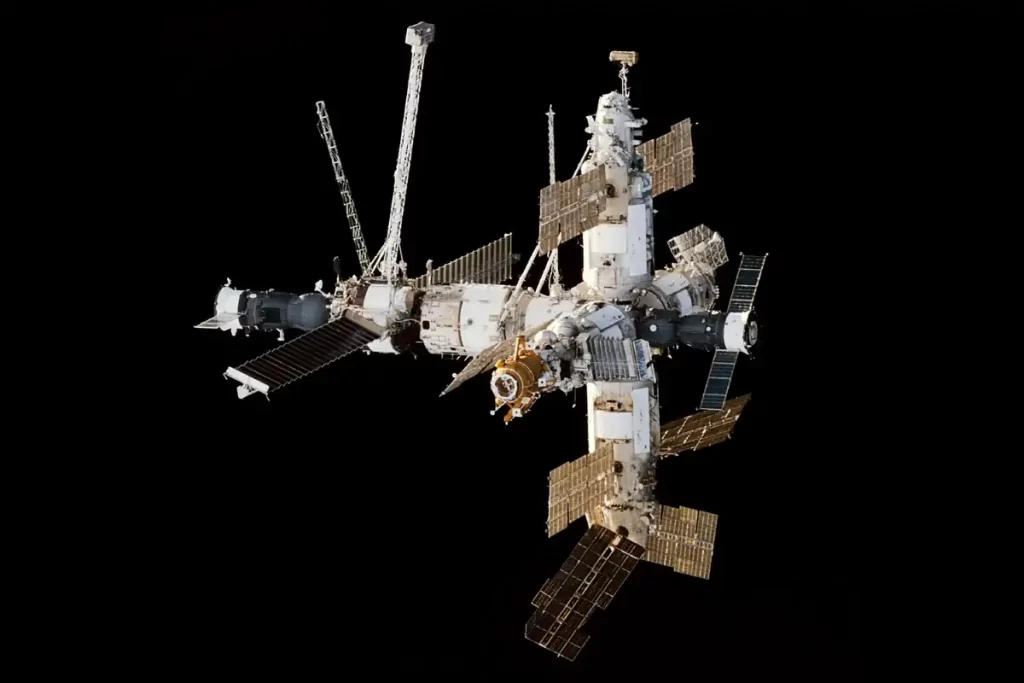On March 23, 2001, after 15 years and more than 86,000 total orbits, Russia’s Mir Space Station was deorbited at 9 a.m. Moscow time. The 134-ton space structure broke up over the southern Pacific Ocean. Some of its larger pieces blazed harmlessly into the sea, about 1,800 miles east of New Zealand.
Today’s (March 23) story of what happened this day in Science, Technology, Astronomy, and Space Exploration history.
Mir’s deorbit
Mir’s deorbit was carried out in three stages:
- A Progress M1-5 cargo ship docked to Mir and laden with fuel initiated the final braking maneuver, starting Mir’s descent. The braking maneuver reduced the station’s orbit to an average of 220 kilometres (140 mi).
- The second stage was the transfer of the station into a 165 × 220 km (103 × 137 mi) elliptical orbit. This was achieved with two burns of Progress M1-5’s control engines at 00:32 UTC and 02:01 UTC on March 23, 2001.
- The third and final stage of the deorbit began with the burn of Progress M1-5’s control engines and main engine at 05:08 UTC, lasting 22+ minutes. At approximately 100 km (60 mi), Mir entered the atmosphere at 05:44 UTC and friction began to heat the outer surfaces. The initial breakup began at about 95 km when aerodynamic forces tore off the solar panels.
After the deorbit, some of Mir’s larger pieces blazed harmlessly into the sea, about 1,800 miles (almost 3,000 km) east of New Zealand. Observers in Fiji reported spectacular gold- and white-streaming lights.
Hugh Williams, a NN correspondent on the island of Fiji spotted streaking debris and heard resulting sonic booms soon after the space station began its descent. He said the fallout was “making a huge golden trail through the sky. We’re just in awe. It’s a collection of bright golden lights tearing across the sky.”
“Perhaps five large fragments fell apart into several more fragments in front of my eyes,” Williams added. “The speed and the size of the object was amazing, like something out of a science fiction movie.”
An amazing saga and a highly successful program finally had come to a watery end.
Mir space station
Once the “crown jewel of the Soviet space program”, Mir was a space station that operated in low Earth orbit from 1986 to 2001, operated by the Soviet Union and later by Russia.
It was the first modular space station and was assembled in orbit from 1986 to 1996. It had a greater mass than any previous spacecraft. At the time it was the largest artificial satellite in orbit, succeeded by the International Space Station (ISS).
For 15 years, Mir space station served as a microgravity research laboratory in which crews conducted experiments in biology, human biology, physics, astronomy, meteorology, and spacecraft systems with the goal of developing technologies required for permanent occupation of space.
The space station survived the collapse of the Soviet Union in 1991, as a stranded cosmonaut, Sergei Krikalev, watched the events unfold below. It hosted space shuttle astronauts, a Japanese reporter, Toyohiro Akiyama, and a British candy chemist who won a contest for the trip – Helen Sharman who also became the first British citizen to go into space in 1991.
Near the end of its life, there were plans for private interests to purchase the station. Private investors sought to revive Mir in 2000, leasing the decrepit, desolate station to make it an exotic destination for wealthy tourists. But renovation funds proved scarce and a $20 million deal to send the first customer to Mir fizzled.

Video: Live Coverage Of Mir Space Station’s Atmospheric Re-Entry
Sources
- Mir Space Station on the NASA History website
- Mir on Wikipedia
- Space Shuttle Endeavour’s Touchdown Meets Columbia’s Salute [An amazing photo from the past] - February 29, 2024
- Moon Landings: All-Time List [1966-2024] - February 23, 2024
- From Orbit to Ordinary: 10 Earthly Applications of Space Technology - January 23, 2024
